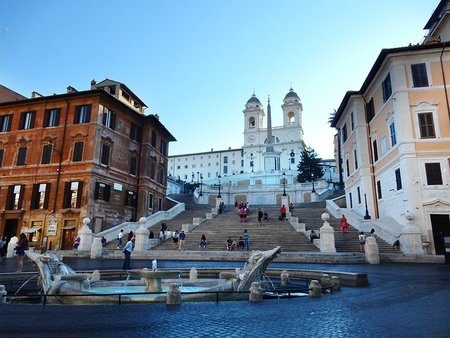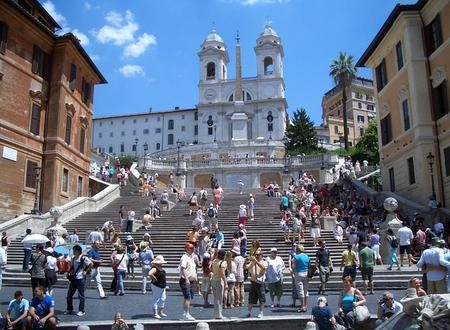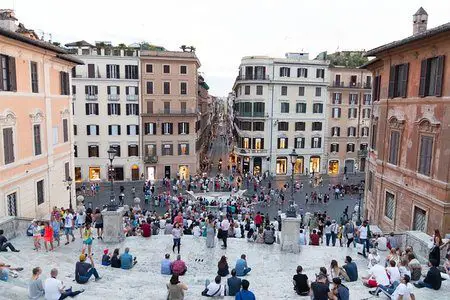The Spanish steps are a group of stairs in Rome (Italy) that have become a cultural landmark. The most attractive members of the Roman society converge here and the best street artists stop by to paint them while the best street musicians stop by to brighten the atmosphere by impromptu gigs. The rest of Roman citizens as well as tourists hang around, chat and gossip while watching the electrifying atmosphere.
In Rome the Spanish Steps are ‘The’ place to be…everyone has been here scores of times and if you are visiting Rome then your Instagram account deserves at least a couple of pictures with the Spanish steps in your background. The 1953 smash hit Roman holiday had the Spanish Steps in some memorable sequences….Audrey Hepburn and Gregory Peck immortalised the location. The whodunit ‘Talented Mr Ripley’ also featured the Spanish Steps prominently. The steps have also featured in many songs like the one by the progressive rock group Refugee and the Bob Dylan song ‘When I paint my masterpiece’.
The Spanish Steps connect the lower Piazza di Spagna (considered to be Spanish territory) with upper piazza Trinita dei Monti that’s a French church. Though there are so many other monuments and buildings in Rome that are architecturally superior, the Spanish steps are more popular than many of these. The steps represent a confluence of culture (people of different backgrounds converge here), fashion (catwalks happen here in summer) and a history of peace and tolerance (the steps signify Spanish French peace).

This is not an attraction to be rushed through… sit on the steps and admire its different levels and terraces and savour the views from the top. Read the article below thoroughly…it shall tell you all there is to know about this unusual attraction.
History
The Spanish square or Piazza di Spagna is joined to the Trinita Del Monti; a French church (this stands on a hill) by a long flight of stairs allied the scalinata Della trinita dei Monti. Locally and internationally, the steps are popularly referred to as the Spanish steps. The concept of joining the square and the church first stemmed in the 17th century when France and Spain had established a long sought for peace. The stairway was finally built in 1723 after a series of designs from leading architects and budding designers all across the world were studied.
On a deeper level the steps were aimed at celebrating the newly established peace stance between France and Spain. The French diplomat Etienne Gueffier granted 20,000 Scudi for the creation of these steps. The celebrated architect and Alessandro Specchi and a little known architect Francesco de Sanctis designed the staircase after their designs were chosen from a large pool of applicants. Incidentally the French had also planned to build a Louis XIV of France statue at the top of the stairs but the Pope Innocent XIII had not approved the idea leading to a disagreement between the French financier and the pope and a delay in starting the construction work.
With a French man funding the project and a French church atop it, it’s natural to expect that the steps would be named French steps. The original name of the steps was trinita dei Monti (inspired by the church) but the immense popularity of the lower plaza that has the Spanish embassy (full of designer shops and boutiques) organically provoked the locals to call it the Spanish steps.
This is a large and attractive stairway of 138 steps and they are not at all regular. You will find gently curved steps, straight flight of chairs, terraces and vistas amongst the Spanish steps creating a dynamic and non-uniform gathering space. The steps are rather shallow and are punctuated by terraces that can help you catch your breath. They are built in the Baroque style that was so popular in the 17th century.

As mentioned earlier the steps attracted tourists, artists, photographers and celebrities equally. This was the “it” place in Rome and prior to 2015 it was a common practice to sit and lunch on the Spanish steps. The stairs began to attract a lot of attention and a few misdemeanours. For example on 13th June 2007 a drunk man attempted to drive a Toyota Celica down the Spanish steps and scuffed many of the steps.
Unfortunately the Romans did not treat their landmark well…the steps got discoloured due to the ravages of years of pollution, wine splashes and blotches of coffee and chewing gum. In 2015 loyalists of Feyenoord Rotterdam Club ravaged the La Barcaccia fountain when they were in town for a match against AS Roma.
Finally there had to be a 1.5 million pound restoration project which restored the beauty and sanctity of the steps. The project began in 2015 and ended in September 2016 during which it was closed to the public. Incidentally the project was undertaken by the iconic jewellery and fashion house Bulgari which considers the Spanish steps to be entwined with their history.
The steps actually connect Via Sistina (this is where Bulgari’s first store opened in 1884) to current showroom in Via Condotti. The renovation project was also used to mark the 130th anniversary of the brand as mentioned by the CEO Jean Christophe Babin. Interestingly Bulgari joined the team of Fashion brands to have undertaken a monument restoration project in the city. Previously Tod’s had contributed majorly to the restoration of the Colosseum and Fendi had restored the Trevi fountain.

If you happen to visit the Via Condotti store of Bulgari you can view the exorbitant and exquisite necklace that has been crafted by Bulgari and inspired by the Spanish steps on the occasion of the unveiling of the newly restored steps. The steps were unveiled in September 2017 after a year of reconstruction work (they were closed off to the public) and there was a grand celebration with the Orchestra Nazionale Cecilia performing and exquisite light and sound shows.
Right now there are several restrictions like no one is allowed to lunch on the steps anymore. Roman Mayor Virginia Raggi made sure that the city pledged to keep its favourite monument clean and shiny henceforth. However access hours to the steps were not restricted; the steps are accessible both during the day and night. Watching the sunset from the Spanish steps and admiring the views from its top should definitely be on your Roman holiday list.
What To See & Do
The steps are flanked on all sides by delightful attractions and cultural landmarks so there is never a shortage of things to do and see. The steps in themselves are graceful, Baroque style and very photo friendly….they mostly remain crowded with tourists and locals.
Piazza di Spagna
Also called the English square of Spain, the Piazza di Spagna is one of the best known squares of Rome. The name is derived from the 17th century dated palazzo di spagna that’s the Spanish embassy’s home for the Vatican. The nearby high street shopping havens like Via Condotti, Via Babuino and Via Frattina have made the Piazza Spagna very popular. There are lines of 17th and 18th century villas here that are a treat for the eyes.
Piazza Del Popolo can be reached if you walk straight down Via Babuino and you will reach the Flaminio obelisk. Read on to know why it’s special. The Via dei Condotti in this area is the best place in Rome for luxury shopping….you will find all top brands like Valentine, Gucci, Fendi, Prada, Bugari etc. here.
Fontana della Barcaccia
The Fontana della Barcaccia or the ‘Fountain of the sinking ugly boat’ was created by Gian Lorenzo Bernini and his father. The fountain has a distinctive shape that’s intended to represent the flood of the Tiber River in 1598. It said that in those times a stray and ravaged looking fishing boat arrived at the fountain’s exact spot prompting the pope to order building a fountain that marked the strange event. Architects say that the sinking boat design is an intelligent choice….it helped Bernini solve a low water pressure issue that was impeding his fountain work.
Inspect the fountain closely and you will see the sun and Bee (symbols of the illustrious Bernini’s family) and an oblique reference to Pope Urban VII.
Church of Trinita dei Monti
Rome’s highest church is located above the Spanish steps and like the staircase, this too owes its existence to France. The full name is Santissima Trinita di Monte Pincio or the Holy Trinity of Pincio (the hill on which church is perched). Once upon a time French king Charles VIII donated a vineyard here to an order of friars but the vines have now died. The adjacent convent still exists.
The church dates back to 1502 and has Gothic elements like a cross vaulted ceiling and pointy arch. There are two perfectly symmetrical bell towers here that give the church aesthetic harmony; one has a clock and the other a meridian… the design was created by Giacomo Della Porta. If you have spare time, do have a look inside the church; there are some beautiful works of art inside. Don’t miss the cycle of frescoes created by Zuccari brothers who worked for 25 years to recreate images of the Old Testament and the New Testament.
The disposition fresco made by Daniele da Volterra is also very beautiful. Don’t miss the perspective gallery created by Andrea Pozzo….it connects the church to the convent mentioned earlier. The star here though is a grand pipe organ by a French master. In a way getting access to this church was the primary purpose of building the staircase. There are only 5 French catholic churches in Spain and the Trinita is the best of them.
Obelisco Sallustiano
An obelisk (called Obelisco Sallustiano) looms in front of the church (you can see it from the bottom of the Spanish steps). This was built in the second century by the Romans who copied the design of the Egyptian obelisk (flaminian obelisk) that’s 3,200 year old. The older obelisk (supposedly the tallest in Rome) is in Piazza Del Popolo and it’s a dedication to Pharaoh Ramses II. The one that’s above the Spanish steps was earlier located at the Sallust gardens and it was later moved to this location after Pope Pius requested.
Colonna dell’Immacolata
The south east corner of the square is the Colonna dell’Immacolata or the column of the Immaculate Conception. Incidentally this column was buried under a monastery and was discovered in 1777. It was erected here in 1857 to celebrate the dogma of Immaculate Conception. A lovely Virgin Mary statue now stands on top of it. The Pope pays a visit to the statue during the feast of Immaculate Conception (an event popular amongst the Italians) and lays a wreath of flowers at the feet of the virgin.
Once you have sat, talked and photographed the steps it’s time to visit the many interesting shops, places and cultural landmarks that surround it.
Keats Shelley Museum
There is the Keats and Shelley Museum (Piazza di Spagna, Phone: 39066784235) full of memorabilia connected to the English romantics… worth a visit for poetry fans. John Keats used to live in the building adjacent to the steps. You will find it at the right corner when you begin to ascend the steps. John Keats died in this place in 1821 and his bedroom has been kept intact since then.
Babington’s Tea Rooms
To the left side of the steps (opposite the Keats museum) there is Babington’s that’s an English tea room with an old history. If you are yearning for some old fashioned English tea…know that very few places including this in Rome has been serving this need since 1893. This was established by two English residents Anna Babington and Isabel Cargill to popularise tea consumption at a time when Romans could only buy tea in pharmacy shops.
Another controversial yet interesting landmark is Italy’s first Mcdonald’s store….this was established in 1986 and locals immediately began protesting that a fast food chain had no place in a historic zone of Rome. Interestingly this was when Italy’s famous slow food movement was born…a counter offering to the fast food industry. You can also explore the tiny cut flower market that has now sprung up on the Spanish steps.
If you are an avid walker then take a short walk from the Spanish steps towards the Trevi Fountain… the architectural beauty and cultural dazzle of the area will inspire you to make your walk longer and then walk to the Pantheon or even the Piazza Navona. You can take a lovely walk inside the Villa Borghese Park (entry near the top of the Spanish steps) that’s full of walking trails, zoo, carrousel, cafes, pony rides and a tiny cinema apart from the well-known Galleria Borghese (you need a reservation to enter this). Another nice though daring attraction 10 minutes away from the steps is the Capuchin Crypt that artistically displays the remains of 4000 Capuchin friars. Chandeliers are made from bones here so don’t go if you have small kids with you!!
Tours & Best Time To Visit
Best time to visit the Spanish steps would be spring when a mass of pink azaleas decorate the steps creating a fairy tale atmosphere. The flower decoration continues for a month till May as Rome’s founding is celebrated on April 21st. in summers fashion shows by top brands are held using the steps as a breathtaking backdrop.
Between the morning and the evenings….the evenings are preferable for visiting the steps; the setting sun makes the views and atmosphere more beautiful. You can see the narrow cobbled streets around fill up with lights and unique signage. Evenings are also great when street musicians come out and play popular music as well as their own creations….some of them even sell C.D’s. However if you want to visit the steps with least amount of crowds; early mornings are the best time.
At the onset of Christmas a beautiful 19th century crib is displayed in the first level of the steps. Many special events have inspired special décor themes for the steps. When the Berlin wall fell; the steps were decorated with multimedia constructs related to the event. Now that the steps have been refurbished and reopened there are frequent musical performances and light shows there. In the rare event of a Roman snowfall, the steps and the whole city become a lovely fairyland.
You can find various options for guided tours of Spanish Steps (including combination tours with other attractions) and book online from this Viator site.
Location & Conveyance
The Spanish steps lies in the historic centre of Rome….a zone full of monuments, boutiques and narrow lanes. The best way to reach the steps is by Metro…just take the red line (line A) and exit at the Spagna station that’s next door to the Spanish steps. If you plan on reaching by bus then know that most city buses will only go up to the Barberiini or Piazza del Popolo that are a 10 minute walk away.
From the Termini station you will get a direct bus that reaches the Trevi fountain (15 minute walk away) ….look for the ATAC S.p.A. Azienda per la mobilità, there is a large taxi stand at Piazza Mignanelli that’s south of piazza di Spagna. If you can, do walk up to the Spanish steps from the Trevi fountain or at least the Piazza Del Popolo/ Flaminio. Walking is really the best way to explore the historic centre of Rome.
The streets surrounding the Spanish steps are very narrow so it’s difficult bringing large vehicles in there. There are lots of pickpockets in this area so keep your belongings safe. Should you feel minor hunger pangs pop inside the Babington tea room. The tea here will come with light airy refreshments and lots of crystal, china and Edwardian waitresses.
For a light Mediterranean meal you can target Cucina & Vista . The Imago on Piazza della Trinita dei Monti serves excellent Italian seafood and a few Asian fusion dishes. Try fine dining stuff like quail eggs stuffed penne and sweet buffalo mozzarella here….you won’t be disappointed.
 A travel addict. Still celebrating the day when he quit his high-profile corporate job to pursue his passion for travel writing.
A travel addict. Still celebrating the day when he quit his high-profile corporate job to pursue his passion for travel writing.